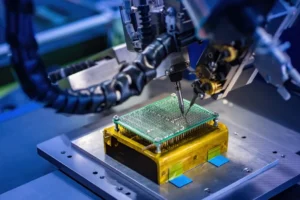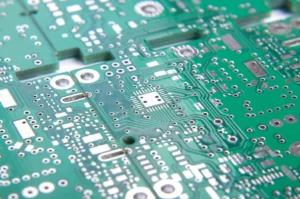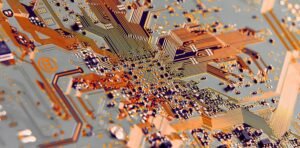In modern electronics, PCB thermal management is no longer a secondary consideration—it’s a design necessity. As devices become more compact and power-dense, effective heat dissipation ensures system reliability, safety, and performance. This article explores the core concepts, materials, methods, and design strategies critical for thermal modeling and heat management in PCBs.
What Is PCB Thermal Management and Thermal Modeling?

PCB thermal management refers to the strategies and techniques used to control the heat generated within a printed circuit board during operation. Thermal modeling is a simulation process that predicts heat distribution and identifies potential hotspots within the PCB. By using thermal analysis software, engineers can anticipate and resolve heat issues early in the design phase, reducing risk and improving thermal efficiency.
Why Is PCB Heat Dissipation So Important?
Excessive heat in a PCB can degrade performance, shorten component lifespan, and even lead to total system failure. As power levels rise and components are packed more tightly, managing thermal loads is critical. Proper heat dissipation improves reliability, supports regulatory compliance (such as UL standards), and enhances the overall user experience by maintaining consistent device behavior.
Common PCB Heat Dissipation Techniques
Several standard methods are used to reduce heat on a PCB:
- Heat sinks: Attached to components to pull away heat
- Thermal vias: Conduct heat through the board to dissipate in other layers
- Copper pours: Large copper areas that absorb and spread heat
- Thermal pads and interface materials: Improve contact between components and heat sinks
- Conformal coatings: Offer thermal and environmental protection
What Substrates Are Used in PCBs?
PCBs are typically built using materials such as:
- FR-4: The most common, glass-reinforced epoxy laminate
- Aluminum-core laminates: Used for high-heat applications like LED lighting
- Ceramic-based substrates: Offer excellent thermal conductivity
- Polyimide and PTFE: High-performance materials used in aerospace and RF applications
How Do PCB Substrates Impact Heat Dissipation?

The thermal conductivity of a PCB substrate determines how well it can transfer heat. For example:
- FR-4 has relatively poor thermal conductivity (~0.3 W/m·K), making it less ideal for high-power designs
- Aluminum substrates typically offer 1–2 W/m·K and integrate a metal core for better heat transfer
- Ceramic materials can exceed 20 W/m·K, making them ideal for extreme conditions
Choosing the right substrate affects not only heat performance but also mechanical strength, cost, and manufacturability.
Eight Expert Techniques to Enhance PCB Heat Dissipation
Avoid Thermal Bottlenecks in Pads and Traces
Narrow traces or undersized pads can become thermal bottlenecks, impeding heat flow and causing localized heating. Always ensure that power traces and thermal pads are generously sized, using wide traces, polygon pours, and short thermal paths. For surface-mounted power devices, use thermal relief patterns only when soldering requires it—otherwise, a solid pad connected with many vias offers better thermal conductivity.
Implement Multi-Layer Thermal Via Arrays Under Heat Sources
Placing thermal vias beneath heat-generating components is one of the most effective ways to direct heat away from the surface. Instead of a few isolated vias, engineers should use dense via arrays (e.g., 8×8 or larger) filled or plated-through to transfer thermal energy vertically to internal copper planes or external heat sinks. For higher effectiveness, vias should be directly under thermal pads and connected to large internal copper planes, ensuring minimal thermal resistance.
Increase Copper Weight and Plane Coverage

Copper thickness significantly affects thermal conductivity. A standard PCB uses 1 oz copper (≈35µm), but for high-power applications, consider 2 oz or 3 oz copper layers. Beyond thickness, expanding continuous copper pours—especially on power and ground layers—creates large-area thermal paths. Use solid fill zones under high-power components and avoid unnecessary segmentation that limits heat flow.
Strategic Component Placement Based on Thermal Profiles
Rather than random placement, group components by heat profile. Position high-power devices near board edges or near openings in the enclosure to allow for natural or forced airflow. Maintain adequate spacing between heat sources to avoid local hot zones. Critical analog or temperature-sensitive components should be isolated from heat clusters, preserving their accuracy and longevity.
Integrate External Heat Sinks with Thermal Interfaces
External heat sinks can drastically reduce component junction temperatures, especially when combined with high-efficiency thermal interface materials (TIMs) like phase-change pads or thermal pastes. Mounting holes and mechanical interfaces should ensure firm, uniform contact pressure between the component and the sink. Also, consider heat sinks with finned geometries optimized for your airflow type (natural or forced convection).
Design Copper Heat Spreaders Across Layers
A layered heat spreader approach is particularly effective. Use solid copper pours on both the top and bottom layers and connect them with thermal vias for vertical heat transfer. Inside the PCB, dedicate one or more internal planes to act as thermal reservoirs, absorbing and redistributing heat over a larger area to prevent local temperature spikes.
Use High-Thermal-Conductivity Substrates or Metal Cores

Standard FR-4 is limited in thermal performance. For heat-intensive applications like LEDs or motor drives, use metal-core PCBs (MCPCBs) or ceramic-based substrates. Aluminum-core boards, for instance, offer better heat dissipation paths and can be directly bonded to heat sinks. Ceramics like AlN or Al₂O₃ provide superior thermal conductivity and electrical insulation, ideal for compact, high-reliability systems.
Model Airflow and Encourage Natural or Forced Convection
Thermal modeling using simulation software (like Ansys Icepak or Autodesk CFD) helps visualize and optimize airflow across the PCB. When possible, design for vertical airflow paths to exploit natural convection. In sealed enclosures, implement forced-air cooling using fans, heat pipes, or blowers positioned to direct air over the hottest areas. Component orientation can also influence convection patterns—consider these during placement.
Thermal Considerations in PCB Design

When designing for thermal performance, engineers must factor in:
- Power dissipation per component
- Ambient operating temperature
- Airflow conditions (natural or forced convection)
- Placement of high-power components
- Board orientation and enclosure ventilation
Each factor affects the temperature gradient across the PCB and determines how heat flows through the system.
Improving Heat Dissipation Through PCB Layout
Effective PCB layout design plays a major role in managing heat. Strategies include:
- Placing hot components near board edges to access cooling airflow
- Separating power and signal layers to reduce thermal interference
- Using thermal reliefs in pads to balance solderability and heat transfer
- Minimizing trace resistance to avoid excess heat from current flow
Thermal Pad Design for PCB Heat Management

Thermal pads, often placed under power components like MOSFETs or regulators, are vital for heat transfer. Best practices include:
- Connecting thermal pads to large copper areas
- Using multiple vias in the thermal pad area to transfer heat to inner or bottom layers
- Applying solder paste evenly for good thermal contact
- Avoiding solder voids that act as thermal insulators
Conclusion
Effective PCB thermal management is essential for modern electronics, impacting performance, reliability, and product longevity. From selecting the right substrate to optimizing layout and component placement, every decision contributes to better heat dissipation. By integrating thermal modeling and thoughtful design from the start, engineers can ensure that their PCB solutions meet both functional and thermal demands in any application.






